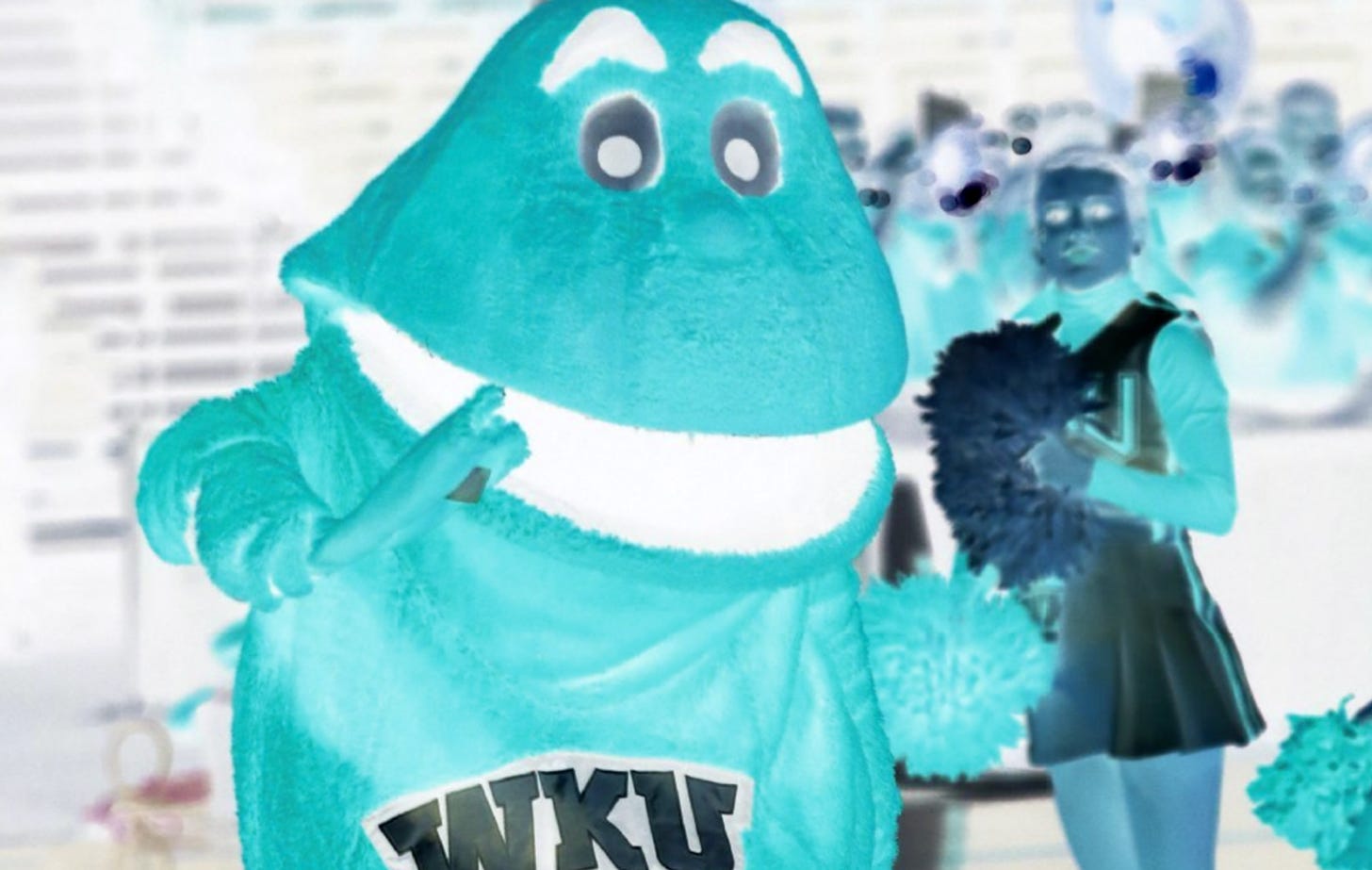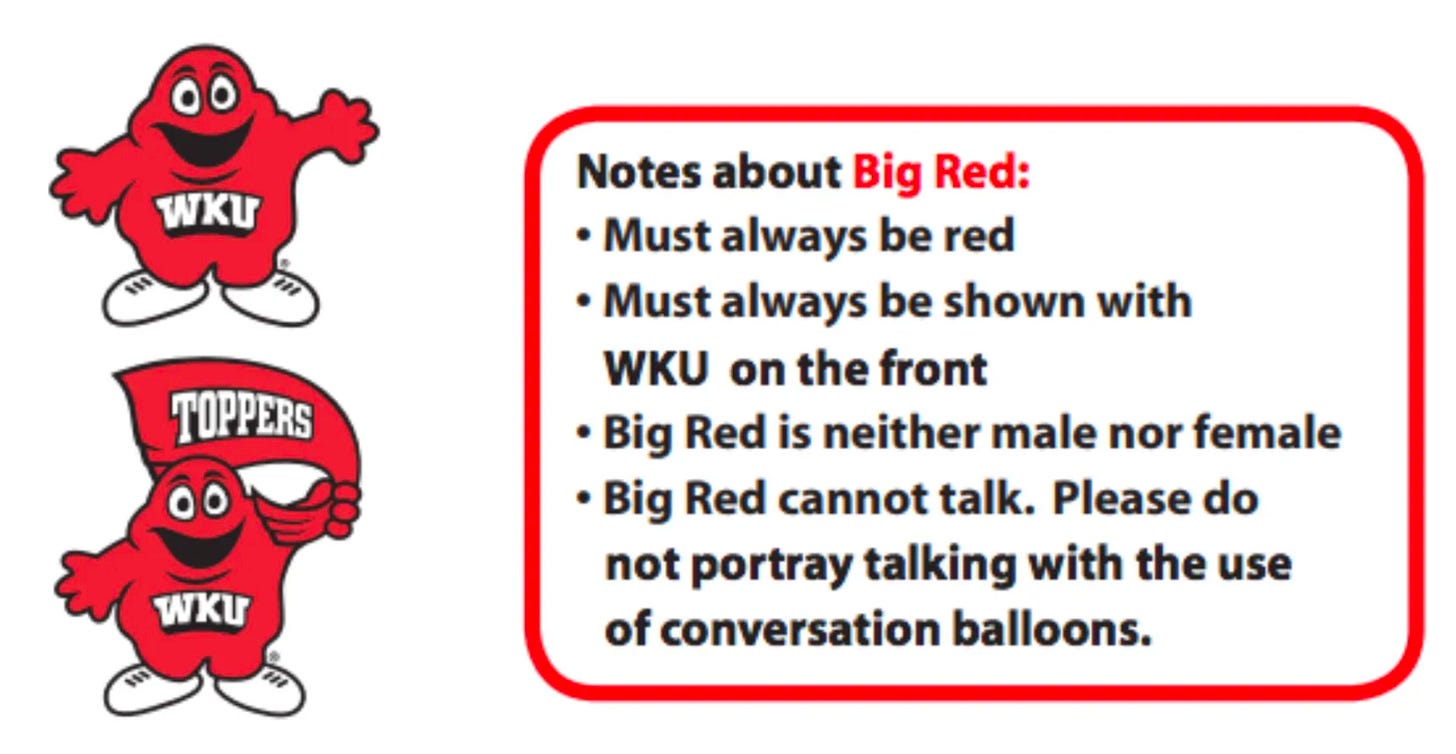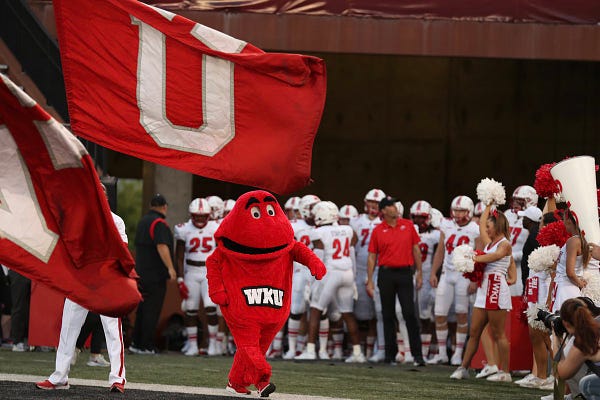Welcome to Flashlight & A Biscuit, my Southern culture offshoot of my work at Yahoo Sports. Thanks for reading, and if you’re new around here, why not subscribe? It’s free and all.
This week in issue #50:
Facing your nightmares, in mascot form
A chance to do some good after having some laughs
An interview on the ‘80s NBA with author Pete Croatto
A few years back, I took my young daughter to a Georgia game against Clemson. Somehow we ended up with student-section tickets, so we were surrounded by pickled undergrads in various stages of inebriation. (Clearly they’d properly smuggled in plenty of contraband liquor.)
My daughter spotted Clemson’s tiger mascot dancing on the sidelines. An aficionado of the works of A.A. Milne, she immediately assumed the dancing mascot was Tigger, and nearly jumped out of my arms pointing to him and laughing, “Tigger! Tigger!”
“No no,” whispered one well-lit young Georgia coed, shaking her head in solemn warning. “Thass eeeeevil Tigger.”
Ever since then, my daughter has deemed the Clemson mascot the most evil of them all.
But she’s wrong. As evil as The Tiger may be, it’s no match for the true horror of this world: Big Red, the amorphous, asexual, dead-eyed Western Kentucky mascot. Part hellspawn, part genetic mistake, part crime against God, part cult leader, all terrifying:
Mascots are weird as hell even in the best of circumstances, mute foam-headed creations that serve to both fire up and vaguely unsettle their student bases. We expect them to be phenomenally athletic, but we also want to see them face-plant, too.
“A clown is funny in the circus ring,” legendary horror film actor Lon Chaney once said, “but what would be the normal reaction to opening a door at midnight and finding the same clown standing there in the moonlight?”
Lon Chaney never met Big Red, but the thought of seeing this soulless apparition in the dead of night is every bit as terrifying.
Big Red first heaved his way into existence back in 1979. The creation of a gentleman named Ralph Carey, Big Red split the difference between a traditional mascot and the then-popular San Diego Chicken. Carey wisely opted against any kind of hillbilly mascot, and settled on the bright red blob who’s a genetic mystery to everyone, even himself:
Western Kentucky has a style guide for Big Red, but this seems more like aspirational prayer than actual mandated behavior:
“Big Red is neither male nor female.” What kind of gleefully-grinning mute horror show is this? Here’s what we do know: Big Red is middle-aged.
Oh yeah! Big Red’s hitting the gym again, and this time it’s really going to stick! Next thing you know, it’ll be listening to Olivia Rodrigo and learning how to use TikTok! Age ain’t nothing but a number, just like the number of pets in the WKU area that go missing every time Big Red goes for a walk around town!
Also, as SB Nation notes, the fact that Big Red has a birthday indicates that Big Red is the product of reproduction … and that reproduction implies that one way or another, Big Red is packing reproductive organs. Enjoy that image.
ANYway, here’s why I’m busting on ol’ Red: to set up an actual serious request.
The city of Bowling Green, where WKU is located, suffered a direct hit from devastating tornadoes last weekend. The tornadoes were some of the fiercest in American history. Dozens of people across multiple states died in the storms, most in Kentucky. The survivors now have to put their lives back together from the wreckage, and some good organizations are stepping up to help them, including:
If you have a few minutes and a few bucks to give, please do so. Some good people lost everything last week. Think about helping give them a little something back.
Five Qs and a song: Pete Croatto, author, “From Hang Time To Prime Time”
I’m an easy mark for sports history books that encapsulate an entire narrative of an era, and one of the best I’ve read lately is Pete Croatto’s comprehensive history of the NBA in the 1980s. David Stern, Magic Johnson, Michael Jordan and so many others navigated the NBA from a tape-delayed, drug-laden slog in the ‘70s to a rollicking, zeitgeist-defining extravaganza in the ‘80s and beyond. Pete captures this entire run in his spectacular book, and I can’t endorse it highly enough. Here’s my interview with Pete; read this, and then grab a copy of “From Hang Time To Prime Time” wherever you purchase your books, such as, for example …
First off, congrats on the book. I devoured it over a weekend. You did so much research and it’s clear how much the era meant to you — but give me an example of a time when your reporting changed your mind about what you thought you knew of the 1970s/80s NBA.
Thank you, sir. I really appreciate that. The last thing I wanted this book to be was a homework assignment.
My mind was changed on a daily basis. I'm serious. I did 315 interviews for this book on top of reading countless books and articles. Every day I'd leave my basement office amazed at what I had learned that day. And, to be honest, there's still stuff I don't know because I ran out of time or sources didn't get back to me or I committed an oversight. As Meghan Daum wrote, never in the history of the world has a complete story been written.
If I had to boil it down to one thing, and I hope this comes across in the book, is that the NBA's rise to power has many heroes beyond the stars. This is not to denigrate what Michael Jordan, David Stern, Magic Johnson, and Larry Bird did, but there is a roster of unheralded heroes who contributed to the NBA's ascension to a global game. I mean, even Larry O'Brien, Stern's predecessor as commissioner, had a gigantic impact because of his reputation in politics and because he had the good sense to realize that Stern was brilliant.
I’m more of a 90s NBA guy, but I’m willing to be convinced. What was it about the 80s NBA that drew you so much?
Here's a confession: I'm a '90s NBA guy, too. I was a baseball fan for most of the 1980s and then the switch flipped in 1991 or so. It was a combination of things. I had a growth spurt, which got me interested in basketball. That led me to NBA Inside Stuff, Knicks games on MSG Network, the Dream Team, and into a chasm of breathlessly narrated highlights and garish apparel and Zander Hollander Complete Handbooks.
I remain fascinated by what I missed. As I grew older, I read an inadvisable number of basketball sports and watched way too many sports videos. I wanted to learn about what led to the game I love today. I kept reading about how the NBA was in trouble in the 1970s and 1980s until Magic and Larry came along and then MJ got kids to buy sneakers and David Stern was a genius and good night, drive home safely. I wanted to write a book that would explore how this evolution happened beyond those highlights. I wanted to write a book that I would be tickled to discover at a bookstore or a library, like when I bought Terry Pluto's Loose Balls at 15. Man, this looks interesting. Let me check this out...
What draws me to that era was that it was the last simple time. The players weren't constructed by AAU ball. They weren't not jaded by the media, who could profile players. Big-time money hadn't entered the photo. Every sport evolves, but the NBA in the 1980s hits my sweet spot: the players still hadn't turned into press-averse, sky-shattering demigods. It felt relatable. I can (sloppily) mimic what Kevin McHale and Patrick Ewing did in the low post. I'm not sure I can do that with any NBA player today unless I want to fall apart like the Bluesmobile.
Please do not misconstrue my affection for the 1980s NBA as derision for today's NBA. I love today's NBA. Every night an abnormal combination of brain power and athletic ability is on display. And it's routine. That's amazing to me. I don't know how someone doesn't watch LeBron James or Kevin Durant and Giannis Antetokounmpo with anything less than awe. I can watch any game and be elated.
For my Atlanta-based readers, please reaffirm ‘Nique’s rightful place in both the NBA universe and the 1988 Slam Dunk contest.
You will hear no argument from me on this, and I'm not saying that as a former Knicks fan whose every spring was a personal hell because of Michael Jordan.
What was it about the South that made it such an appealing location for new franchises in the late 80s?
That's a great question. There are two reasons, in my opinion. First, the rise of regional cable television, which was driven by sports, made the South a popular region for a team, because it came with a potentially giant audience. The Orlando Magic and Miami Heat could, conceivably, grab fans along the Gulf Coast and perhaps into Cuba. The same logic applies to the Charlotte Hornets, who could attract fans in the Carolinas, West Virginia, Virginia, Tennessee, and Kentucky.
Second, the 1980s is also when theme parks and family fun took flight, so having Disney World and Busch Gardens and all these tourism attractions in the same area had to be a nice hook. A basketball arena is right in line. After all, David Stern considered them to be amusement parks in his ersatz Disney empire.
What player(s) from the 80s do you think would thrive in the modern era? Which stars would flounder the most?
The 1980s teemed with players who would thrive in today's NBA: Jordan, Hakeem Olajuwon, Charles Barkley (Russell Westbrook's spirit animal), Scottie Pippen (who'd be Draymond Green x 10), David Robinson, Arvydas Sabonis. They were all smart, super-athletic players who could adapt to the up-tempo style.
One player I can't see doing as well is Patrick Ewing, which pains me, because I loved him with the Knicks. But he was so post-up dominant and lumbering that I can't see him keeping up with Embiid and Jokic and all these other spry Swiss Army centers.
Finally, the song. Music runs throughout the book, part of the culture that helped the NBA break through in the 1980s, but what song would you say epitomizes the NBA in the 1980s?
The easy answer would be "Basketball" by Kurtis Blow or any of the other songs used in the NBA's "It's Fantastic" ads, but I always go back to Marvin Gaye's rendition of the national anthem at the 1983 NBA All-Star Game:
I know the song is a central part of my book, but that encapsulates the NBA's spirit then and now. It's alternately passionate and somber, spirited and reverential. The song just exudes basketball-ness. But the timing is important. To me, Gaye performing the anthem in his style—which was such a stylistic departure—was an implicit statement that the NBA was going to go its own way. It was going to be fun and exciting and star-driven, the very qualities that made people fall in love with the league in the 1980s and now. I'm hard-pressed to think of a version of "The Star-Spangled Banner" that both reflected the game that followed it and changed/predicted its course in the years ahead. It's a legitimate piece of history—and you can dance to it.
Previous Five Qs, One Song:
That’ll do it for this week, friends. Stay safe and stay close — but not too close — to one another. See you next weekend!
—Jay
This has been issue #50 of Flashlight & A Biscuit. Check out all the past issues right here. Feel free to email me with your thoughts, tips and advice. And if you dug this, share it with your friends. Invite others to the party, everyone’s welcome.








